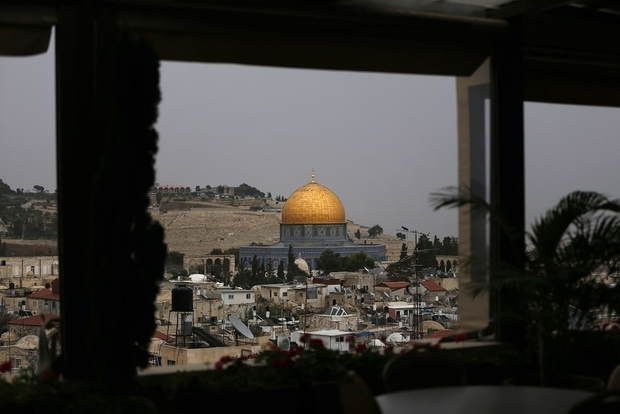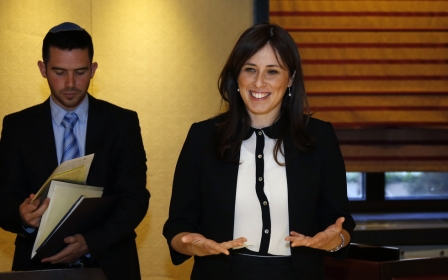Israel’s encirclement of al-Aqsa 'nearly complete'

JERUSALEM - Despite claims it is seeking to calm tensions in Jerusalem, Israel is intensifying activities to encircle the al-Aqsa mosque and strengthen its control over the holy site, a group of Israeli archaeologists warned last week.
The group sounded the alarm as the United States oversaw moves at the mosque compound, known as the Haram al-Sharif, or Noble Sanctuary, intended to end weeks of Palestinian unrest focused on Jerusalem.
US Secretary of State John Kerry brokered an agreement last weekend between Israel and Jordan, the official guardian of the Haram, that will see cameras installed in the mosque compound.
But the archaeologists say the most pressing threats to the mosque, located on a raised plaza above the Western Wall in Jerusalem’s Old City, will be invisible to the cameras.
They accuse Israel of making rapid changes to the physical landscape around al-Aqsa to obscure the area’s Islamic character and create an ever-more arduous “obstacle course” for worshippers.
“The big picture is that Israel is weakening the Muslim and Palestinian presence there so that Israeli Jews can believe they are the true owners of the site,” said Yonathan Mizrachi, head of Emek Shaveh, an organisation of Israeli archaeologists opposed to the use of archaeology for political ends.
Various Israeli archaeological activities, he said, had almost completed Israel’s encirclement of the al-Aqsa compound, isolating it from Palestinian neighbourhoods of East Jerusalem.
24-hour surveillance
Kerry has said he believes the cameras will persuade Palestinians that Israel is not violating a “status quo” agreement governing the site since Israel occupied East Jerusalem, along with the Palestinian territories of the West Bank and Gaza, in 1967.
The unwritten understandings are supposed to ensure that the religious administration of the compound remains solely with an Islamic authority known as the Waqf, while Israel controls policing at the site. Although Jews may visit the mosque area, they are banned from praying there.
Jews refer to the Haram as Temple Mount, arguing that the ruins of two ancient temples lie under al-Aqsa. The Western Wall, revered by religious Jews, is believed to be a retaining wall of the second temple, destroyed nearly 2,000 years ago.
Footage from the cameras will be broadcast around the clock, providing “comprehensive visibility and transparency,” according to Kerry.
In particular, the move is supposed to reassure Palestinians that ultra-nationalist Jews, who have been visiting in ever-larger numbers escorted by armed Israeli police, are not using the site for prayer.
Critics like Mizrachi say Washington’s narrow focus on Jewish prayer at al-Aqsa will fail to ease tensions because it ignores the wider injustices of Israel’s occupation as well as limited access for Palestinians to the mosque and dramatic physical changes Israel is engineering immediately outside the compound.
“It is not just about what is happening on the plaza but what Israel is doing outside the compound to restrict access and prayer rights for Muslims, and to change the character and atmosphere of East Jerusalem and the Old City,” he told Middle East Eye.
“The government and the settlers are working hand in hand to create the impression that the Old City is at the core of Jewish history and identity and must be under Israeli sovereignty.”
Tighter entry restrictions
Palestinian leaders have long complained that Israeli barriers and checkpoints mean few Palestinians from the West Bank or Gaza can still reach Jerusalem or its holy sites.
Increasingly even those living in Jerusalem or from Israel’s large minority of 1.6 million Palestinian citizens face entry restrictions.
Last year, according to official figures, the Israeli police imposed age restrictions 41 times, often preventing any Palestinians under 50 from entering.
For three weeks in late August and September, United Nations observers reported, Israel also denied entry to Palestinian women in the morning hours to allow Jewish groups access to the site. Some 500 Muslim children studying in the compound were refused entry too.
In addition, said Mizrachi, Israeli activities were cutting off the al-Aqsa compound from its Palestinian surroundings. Recent changes included:
* The extension of secretive excavations and tunnelling around the compound to create an “underground Jewish city” on the western and northern flanks of the Haram;
* The transfer of an archaeological park on the western and southern walls of al-Aqsa to an extremist Jewish settler organisation;
* The enforced closure of a historic but active Muslim cemetery, the length of the eastern side of the compound, denying Palestinian families access under the pretext that it falls within an Israeli national park.
Israel had also increased security restrictions for Palestinians on the main thoroughfare through the Old City’s Muslim Quarter to al-Aqsa, further limiting access, Mizrachi noted.
“The goal of all these changes is to emphasise the Jewish character of the environment around al-Aqsa, both above and below ground,” he said.
Pledge to stop Jewish prayer
Israeli officials have denied accusations that the Islamic control at the site is being undermined. Prime Minister Benjamin Netanyahu claimed last month: "Israel is not the problem on the Temple Mount; it's the solution. We maintain the status quo.”
Under pressure from Washington, Netanyahu’s office quietly issued a statement a week ago, late at night and only in English: “Israel will continue to enforce its long-standing policy: Muslims pray on the Temple Mount; non-Muslims visit the Temple Mount.”
Netanyahu has blamed the weeks of unrest in Jerusalem and in the West Bank on what he terms “incitement” by Palestinian leaders.
But there are indications of mounting concerns in Europe and the United States that Israeli measures are weakening the status quo.
One of Kerry’s officials, John Kirby, caused a diplomatic storm by telling reporters last month: “Certainly, the status quo has not been observed, which has led to a lot of the violence.” Following Israeli complaints, he retracted the statement.
At the same time, the UN Educational, Scientific and Cultural Organisation approved a resolution condemning Israel for limiting freedom of worship for Muslims and for its management of holy sites under its control.
A French proposal to place international observers on the mosque plaza was blocked by Washington and Israel.
Many Palestinians fear that ultimately Israel wants either to physically divide the compound to create a prayer space for Jews or to insist on separate Jewish prayer times. Similar arrangements have been imposed by Israel on Hebron’s Ibrahimi mosque since the 1990s.
Israel’s deputy foreign minister, Tzipi Hotovely, added to concerns last week, telling Israeli TV: “My dream is to see the Israeli flag flying over the Temple Mount. It’s the holiest place for the Jewish people.”
Other ministers have called for a third temple to be built in place of al-Aqsa. The Haaretz daily noted last week that extremists calling for the destruction of the mosque now had “power hubs” in Netanyahu’s Likud party and its major coalition partner, Jewish Home.
Secret tunnelling
Mizrachi said al-Aqsa was not just threatened by the activities of a few ultra-nationalists but the combined actions of Israel’s political mainstream, archAeologists and Jewish religious authorities.
He said the government, the Israel Antiquities Authority and the Western Wall Heritage Fund were all working clandestinely on extensive excavations next to the mosque compound to create a network of underground spaces.
The purpose of the tunnelling was unclear, he said. “But it is inevitable that, when they are being conducted so secretively, they fuel concerns among Palestinians that the work could extend under the mosque or damage its foundations.”
He added that Israel was continuing with excavations on the western flank of the al-Aqsa compound that first came to public attention with the opening of the Western Wall tunnels in 1996, during Netanyahu’s first premiership. The opening of the tunnels led to clashes that resulted in dozens of Palestinian deaths and hundreds being injured.
In addition, an Israeli court ordered last month that control of an archaeological park, the Davidson Centre, on the western and southern flanks of the al-Aqsa compound, be handed over to Elad, a settler organisation.
Elad already controls large parts of the Palestinian neighbourhood of Silwan, south of the al-Aqsa compound, where it is developing a Jewish archaeological theme park called the City of David that is displacing Palestinian residents.
Mizrachi said Elad’s role at the Davidson Centre was “disturbing” because it brought the settler group to the foot of the Al-Aqsa compound. Elad, he added, was trying to connect its Silwan complex with the Davidson Centre, as a way to reinforce an exclusive Jewish narrative about ancient Jerusalem.
In September, Israel’s National Parks Authority sealed off with a barbed wire Bab al-Rahmeh, an ancient Islamic cemetery on the mosque’s eastern side, to prevent burials and access for Palestinians.
Emek Shaveh has warned that the move is the conclusion of “a long struggle between settlers and Palestinians over control of the eastern wall of the esplanade”.
During the recent weeks of unrest in Jerusalem, Israel has severely cracked down on Palestinian access to al-Wad Street in the Old City’s Muslim quarter. It is an area Jewish settlers have long targeted for a takeover as it also connects to the Western Wall.
“What is happening over time is that the Haram is getting ever more isolated from its Arab and Islamic surroundings,” Mizrachi said.
Palestinian leaders banned
The physical changes around al-Aqsa have been supplemented by ever-tighter Israeli restrictions on Palestinian political and religious leaders accessing the site, observers have noted.
The PA has been barred from any standing in Jerusalem since the outbreak of the second intifada in 2000. Last month, Netanyahu also ordered all members of the Israeli parliament, including representatives of Israel’s Palestinian minority, from entering the al-Aqsa compound.
Basel Ghattas, a Palestinian member of the Israeli parliament from the Joint List party who had to disguise himself last week to get past Israeli police and on to the plaza, told MEE: “I don’t take orders from Netanyahu about whether I can visit al-Aqsa.”
He added: “When Israeli police determine who gets into al-Aqsa and who doesn’t, it’s clear that they are the real masters, not the Waqf.”
Ghattas, like other Palestinian leaders, was concerned that Israel will use the new cameras to identify Palestinian activists and arrest them or ban them from the site. The cameras, he said, would give Israel control over al-Aqsa “24 hours a day”.
Israel has also repeatedly barred Muslim religious leaders from Jerusalem and al-Aqsa – most notably Sheikh Raed Salah, head of the northern branch of the Islamic Movement in Israel. Other religious figures in Jerusalem, including Hamas political leaders in the city, have been jailed or forcibly relocated to the West Bank.
Salah has made the status of al-Aqsa a key issue and has tried to bring thousands of Muslims from areas inside Israel to pray at the site as Palestinian worshippers from the occupied territories have dwindled.
Last month Prime Minister Netanyahu announced his intention to outlaw Salah’s Islamic Movement.
Zahi Njeidat, Salah’s spokesman, said the status quo at al-Aqsa was empty. “The reality is that Israel decides everything, both in the Haram and outside, because it is the occupier. That is the only status quo intended by Netanyahu and Kerry.”
Njeidat said there would be no calm at the site until the occupation of Jerusalem ended and Palestinians could freely visit and pray at al-Aqsa.
Middle East Eye propose une couverture et une analyse indépendantes et incomparables du Moyen-Orient, de l’Afrique du Nord et d’autres régions du monde. Pour en savoir plus sur la reprise de ce contenu et les frais qui s’appliquent, veuillez remplir ce formulaire [en anglais]. Pour en savoir plus sur MEE, cliquez ici [en anglais].




